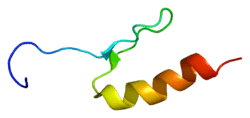Sp3 transcription factor
Sp3 transcription factor, also known as SP3, refers to both a protein and the gene it is encoded by.
This gene belongs to a family of Sp1 related genes that encode transcription factors that regulate transcription by binding to consensus GC- and GT-box regulatory elements in target genes. This protein contains a zinc finger DNA-binding domain and several transactivation domains, and has been reported to function as a bifunctional transcription factor that either stimulates or represses the transcription of numerous genes. Transcript variants encoding different isoforms have been described for this gene, and one has been reported to initiate translation from a non-AUG (AUA) start codon. Additional isoforms, resulting from the use of alternate downstream translation initiation sites, have also been noted.[1]
Interactions
Sp3 transcription factor has been shown to interact with Histone deacetylase 2,[2][3] PIAS1,[4] E2F1[5] and GABPA.[6]
References
Further reading
- Tseng L, Gao J, Mazella J et al. (1997). "Differentiation-dependent and cell-specific regulation of the hIGFBP-1 gene in human endometrium.". Ann. N. Y. Acad. Sci. 828: 27–37. doi:10.1111/j.1749-6632.1997.tb48521.x. PMID 9329821.
- Zhang Y, Dufau ML (2003). "Dual mechanisms of regulation of transcription of luteinizing hormone receptor gene by nuclear orphan receptors and histone deacetylase complexes.". J. Steroid Biochem. Mol. Biol. 85 (2–5): 401–14. doi:10.1016/S0960-0760(03)00230-9. PMID 12943729.
PDB gallery |
|---|
| | 1va1: Solution Structure of Transcription Factor Sp1 DNA Binding Domain (Zinc Finger 1) |
|
|
|
|
|---|
| | | | |
|---|
| | (2.1) Nuclear receptor (Cys4) | | subfamily 1 | |
|---|
| | subfamily 2 | |
|---|
| | subfamily 3 | |
|---|
| | subfamily 4 | |
|---|
| | subfamily 5 | |
|---|
| | subfamily 6 | |
|---|
| | subfamily 0 | |
|---|
|
|---|
| | (2.2) Other Cys4 | |
|---|
| | (2.3) Cys2His2 | |
|---|
| | (2.4) Cys6 | |
|---|
| | (2.5) Alternating composition | |
|---|
| | (2.6) WRKY | |
|---|
|
| | | | | (4) β-Scaffold factors with minor groove contacts |
|---|
| |
| | | (0) Other transcription factors |
|---|
| |
| | see also transcription factor/coregulator deficiencies
Index of genetics |
|---|
| | Description |
- Gene expression
- DNA
- replication
- cycle
- recombination
- repair
- binding proteins
- Transcription
- factors
- regulators
- nucleic acids
- RNA
- RNA binding proteins
- ribonucleoproteins
- repeated sequence
- modification
- Translation
- ribosome
- modification
- nexins
- Proteins
- domains
- Structure
- primary
- secondary
- tertiary
- quaternary
|
|---|
| | Disease |
- Replication and repair
- Transcription factor
- Transcription
- Translation
|
|---|
|
|


